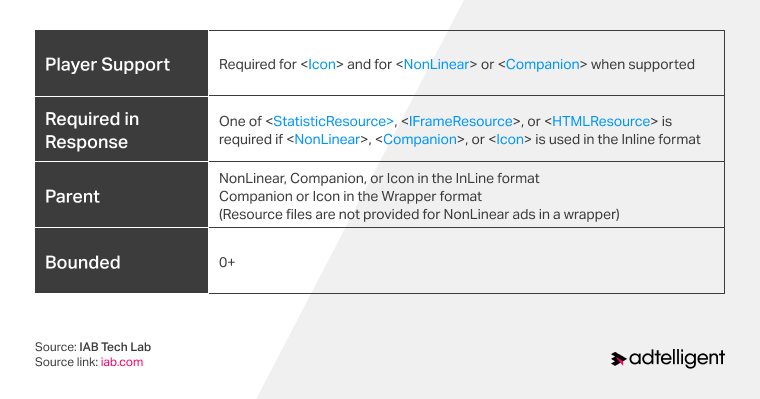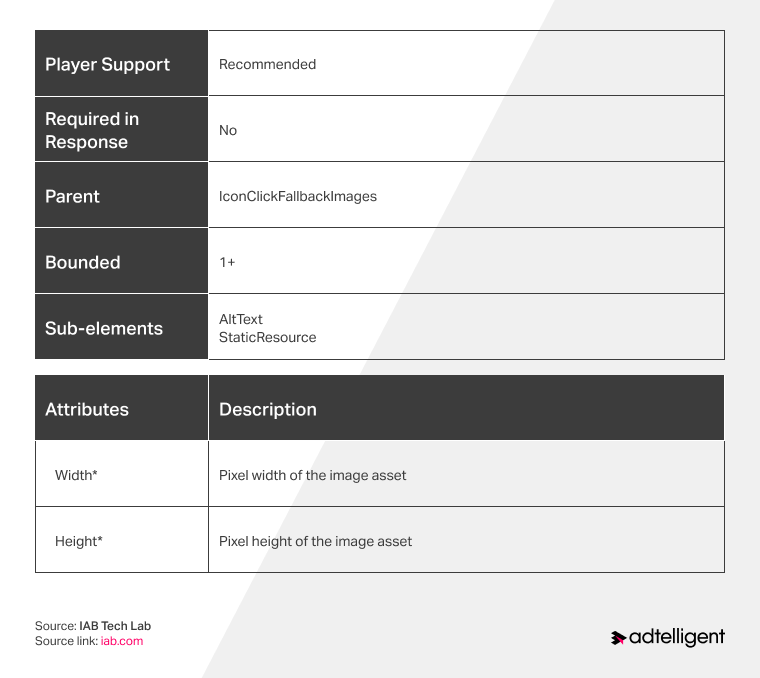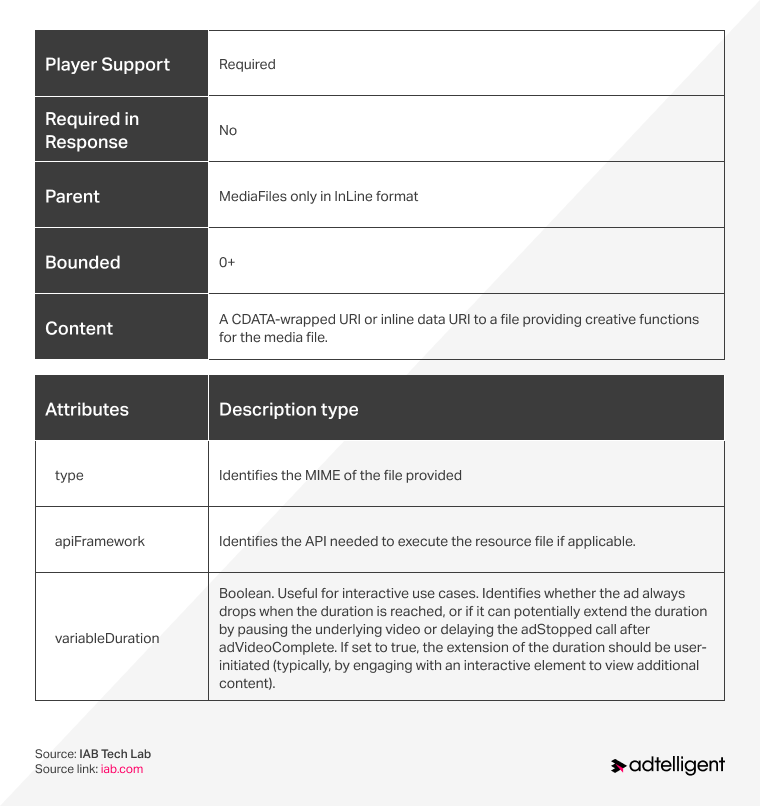Brief History
For the digital advertising ecosystem, VAST is extremely valuable, with a VPAID ad format that automatically supplies ads with an interactive component to a media player. However, delivering causes definite challenges for publishers. For example, if the player doesn’t accept the interactive format, the video ad may fail to display or be slow. VPAID is also used for measurement and verification instead of ad interactive delivery as it was designed. It has been recently replaced by SIMID and OMID standards.

Despite the drawbacks, VAST constantly keeps improving as the digital media marketplace has become increasingly complex. In 2016, VAST 4.0 had many updates through which the ads were displayed more smoother and without interruptions. And now, VAST 4.3 solves several challenges that help create an easy and productive workflow between the partners.
Сomparative table of VAST 4.0 & VAST 4.3

* VPAID has been deprecated as of VAST 4.1. It is replaced by SIMID (Secure Interactive Media Interface Definition) and OMID (Open Measurement Interface Definition). The change is based on improved standards – OMID for measurement and verification and SIMID for interactivity.
Our team praises the latest VAST and its functionality. The most recent updates implemented by VAST that apply to its 4.3 version aim to solve standard advertisers’ problems and satisfy their needs. For example, it has addressed and improved tracking, scoring, and bizarre behavior issues. We also cherish how updated VAST 4.2 can cater to advertisers’ changing needs and respond to the fast-changing digital environment. Besides, several new macros appeared making it easier for users to watch content.
For familiarization with all updates, please, take a look at VAST 4.3 specification.
Recent Changes from VAST 4 to 4.3
IAB Tech Lab added some additional changes and fixes to the VAST 4.3 over time. At the moment, the list of the latest updates includes the following:
- Fixed HTMLResource description & example
A “snippet” of HTML code to be inserted directly within the publisher’s HTML page code. - Creative Resource Files for Non-Video and Non-Audio
NonLinear ads, Companions, and Industry Icons are non-video and non-audio creative, so creative files are nested using elements that define the creative resource file provided: StaticResource, IFrameResource, and HTMLResource. - Fixed IconClickFallbackImage(s) references
The element is used to display information when an icon click occurs. - The VAST Terminology List was updated
- Added reference to “latest” macros list
New macros can be added without requiring a new VAST version at every change. The latest list is being maintained on the IAB Tech Lab’s VAST GitHub repository. - A new macro was added for [PLAYBACKMETHODS]. It indicates continuous play, so now users can watch content episodes one by one without any actions.
- Now one can include inline URI data for interactive creative files, for example when putting HTML instead of URL for retrieving files.



Audio in VAST 4.1
An essential addition to the VAST featured in the 4.1 updates is worth extra attention.
Digital Audio Ad Serving Template (DAAST) was deprecated and replaced by VAST. DAAST defined a standard structure for delivering the details of an audio ad from an ad server to an audio player.

With the release of the 4.1 version of the Digital Video Ad Serving Template, the chance to unify existing video ad specifications with the digital audio ad market became a reality.
Here are the differences in VAST 4.1 as a result of the DAAST absorption:
- Video vs Audio designations are made via the new “adType” attribute in the <Ad> object. Implementations can offer such options as “video”, “audio”, or “hybrid” for ad playback. “Video” is assumed to be a default setting, but other options are available to choose from as well. The “hybrid” option supports video and audio ads within the same supply. Advertisers can use this concept as a video campaign that is not necessarily seen but always heard, as all of the vital information about a brand or service can be transmitted in audio format. All of it is without the need to create a separate audio-based tag. There is also a possibility of richer audio format options.
- DAAST’s concept of <Expires> has been ported to VAST 4.1. It allows a media player to know if the ad server will have any timeout, after which a predetermined ad should be played or not played after all. This feature allows for better implementations of pre-fetched video ads.
- VAST 4.1 spec document clearly states if some functionalities apply differently to audio than video cases.
Audio ads open numerous opportunities for other streaming formats like mobile streaming or car radios. They are now fully integrated into VAST 4.1.
Key takeaways in the latest VAST 4+ updates
In the list below, we can see the main benefits of the latest VAST update compared to the previous versions:
- User experience: by using the latest VAST, publishers may control the user experience and video ads running on their pages due to a ‘player-centric” template. It gives playback control to the player. In addition, the mezzanine file and SSAI support allowed more various devices to be covered and ensured better quality of video ads.
- Better and more diverse video ads: increased support for interactive and audio ads gives a chance to create ads of higher quality without blurry video content. Buyers, in turn, can bring in more creative interactive elements and access multiple verification vendors through one integration.
- Better ad delivery process: fewer errors and more detailed reporting allow for improving the ad delivery process. Macros helped with better device recognition and understanding, thus reducing the number of errors; simplified architecture of delivering ads (via separation of media files from some of the codes) improved the overall process and decreased the number of blank ads. Also, interactive ads may be delivered to all platforms, including OTT and mobile, due to SIMID.
- Improved reporting capabilities: with new VAST updates, the reporting became more transparent, allowing advertisers to see where their ads appear. Simplified tags added greatly to this development, giving more control and allowing the tracking of creative assets.
- Advanced verification capabilities: with new OMID standards that allow one tag to work across all platforms, the latest VAST version provides support across all verification vendors.
- Macross added on GitHub for free management that does not depend on VAST updates.
- Incline data URI can be added for interactive ad files. This may be useful when you want to place HTML code instead of a URL to retrieve the file.
The ad tech industry is in the process of adopting the latest version of VAST. Since adjusting and implementing changes takes time, there is a transition period for phasing out outdated specifications. There is also additional time to organically transition to new standards across the industry. Currently, VAST 4.3 tags have both the AdVerifications node for Open Measurement and the VPAID MediaFile element.